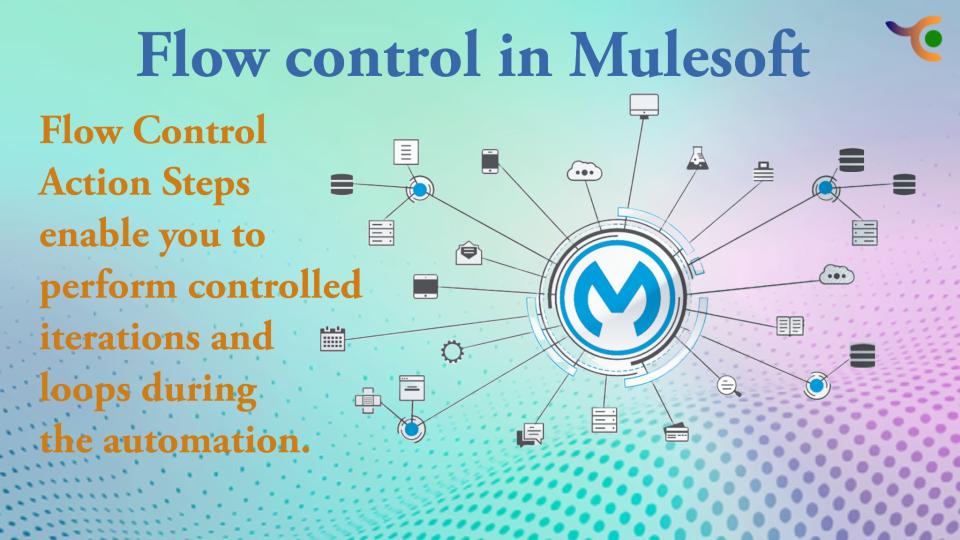Flows are one of the most powerful tools available in any modern application architecture. Flow control is a feature in MuleSoft that allows the definition of rules for how data flows between applications. For this flow control to work, you need to configure the following two things:
- The flow control policy (the rule) and
- The destination (the application or external service).
Flow control is a way to control the flow of data between different systems. It can be used to integrate applications or to control the flow of data between different systems. This can be useful when using APIs that have an API key, as there are many cases where you would want to limit access to certain parts of your system depending on who has access and what they’re doing with it.
Also called “Router”
The major task of the Flow Control component in MuleSoft is to receive the input Mule event and route it to one or more separate orders of elements. It is routing the input Mule event to other sequences of elements. Therefore, it is also called a Router. Choice and Scatter-Gather routers are the widely used routers under the Flow Control component.
Choice Router
So as the name reflects, this router applies DataWeave logic to select one of two or more routes. As mentioned above, each route is a unique sequence of Mule event processors. We can illustrate choice routers as a router that vigorously routes the message through a flow as per a set of DataWeave expressions used to evaluate message content.
Scatter-Gather Router
Another widely used routing event processor is the Scatter-Gather component. As its name hinted, it works on the fundamentals of scatters (copying) and gathering (Consolidates). We can recognize its working with the help of the following points −
- First, this router copies (scatters) a Mule event to two or more parallel routes. The situation is that each route must be an order of one or more event processors which is like a sub-flow. Each route in this case will initiate a Mule event by using a separate thread. Every Mule event will have its attributes, payload as well as variables.
- After that, this router gathers the created Mule events from each route and then merges them into a new Mule event. After this, it forwards this consolidated Mule event to the next event processor. Here the condition is that the S-G router will forward a consolidated Mule event to the next event processor only when every route is completed successfully.
Flow Control Action Steps
Flow Control Action Steps allow you to carry out controlled iterations and loops during the automation.
- Break Loop: Break Loop allows you to exit a Loop control block during its execution.
- File-Controlled Loop: The file-controlled loop reads data from a CSV file.
- Force error state: It simply forces the Workflow into an error state.
- Force OK State: The Force OK state action step can reset an error state to OK.
- Group: It enables you to group action steps for finer visibility and readability.
- Lock Section: The lock section allows you to synchronize access if multiple parallel Workflows are required to access a file or mailbox, for example, in Robotic Applications.
- Loop: A Loop block allows you to perform again the same Transaction and Action Steps two or more times.
- Managed: This block enables you to handle errors within your Workflow as they take place.
- Pattern Select: This allows you to respond flexibly to non-predictable situations.
- Select Case: It makes it feasible to match the contents of a variable against certain predefined cases.
- Transaction: The transaction allows you to split Workflow into logical, self-contained units.
Advantages of Flow control in MuleSoft.
In many cases, you must provide a way for your application to pass the information on from one service or system (like an API) back into another system or service. This type of communication happens all the time in real life—for example, you may want to send personal information about yourself so that another person can see what apps you use, or maybe you’d like them able to access certain features only if they’ve logged into a specific application, or maybe there’s some other reason why each party needs accesses its own specific data source/service.
Why TCI?
TCI has a team of experienced and certified MuleSoft and Salesforce developers. TCI focuses on how we can take away the pain point of our clients. So, they can be able to focus more on the productivity of their organization. TCI is specialized in micromanaging and can handle different working time zone headaches. TCI’s values build the organization stands apart from the world. Besides career growth, TCI offers a balanced life, which can’t only help the employees in their work but also their personal life. TCI’s operation and management teams take care of each employee’s work-balanced life allowing them to work their way.






